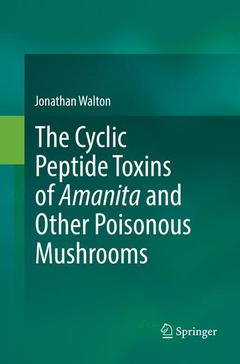Description
The Cyclic Peptide Toxins of Amanita and Other Poisonous Mushrooms, Softcover reprint of the original 1st ed. 2018
Author: Walton Jonathan
Language: English
Subjects for The Cyclic Peptide Toxins of Amanita and Other Poisonous...:
Keywords
amanitin; phalloidin; Amanita; mushroom; cyclic peptide; Systematic Botany
Approximative price 158.24 €
In Print (Delivery period: 15 days).
Add to cart
The Cyclic Peptide Toxins of Amanita and Other Poisonous Mushrooms
Publication date: 12-2018
Support: Print on demand
Publication date: 12-2018
Support: Print on demand
The Cyclic Peptide Toxins of Amanita and Other Poisonous Mushrooms
Publication date: 05-2018
Support: Print on demand
Publication date: 05-2018
Support: Print on demand
Description
/li>Contents
/li>Biography
/li>Comment
/li>
Poisonous mushrooms have fascinated scientists and laypersons alike for thousands of years. Almost all mushroom fatalities are due to the genus Amanita, whose poetic common names (death cap, destroying angel) attest to their lethality. In his classic 1986 book, Theodor Wieland covered the state of our knowledge about the chemistry and biochemistry of the toxins of Amanita mushrooms up until that time, with a particular focus on the decades of chemical research by him and the Wieland dynasty (including his father, brother, brother-in-law, and cousin). Wieland?s book is now mainly of historical interest, with its exhaustive overview of the early chemical studies done without benefit of methods taken for granted by modern chemists.
This book is a complete top-to-bottom revision of Wieland?s 1986 book. The material covers history, chemistry, and biology with equal thoroughness. It should be of interest to natural products chemists and biologists, professional and amateur mycologists, and toxicologists.
The three scientific fields that are most relevant to the book are natural products chemistry, mycology, and fungal molecular genetics. Dr. Walton is an expert in all three. To maximize the broad utility and appeal of the book, care has been taken to define all technical terms specific to a particular discipline, so that, for example, mycologists will be able to understand the relevant chemistry, and chemists will be able to understand the relevant fungal biology.
Introduction.- Chemistry of the Amanita Peptide Toxins.- Distribution and Taxonomic Variation in the Amanita Cyclic Peptide Toxins.- Biosynthesis of the Amanita cyclic peptide toxins.- Biological Activities of the Amanita Peptide Toxins.- Ecology and Evolution of the Amanita Cyclic Peptide Toxins.- Medical and Biotechnological Aspects.- Future Outlook.
Jonathan Walton was raised in upstate New York and the Bay Area of California. He attended high school in Ojai, California, and graduated from the University of California, Santa Cruz, in 1975. He received an MS degree in plant pathology from Cornell University (1978) and a PhD in biological sciences from Stanford University (1982). He was a NATO postdoctoral fellow at the University of Rome “La Sapienza” and worked at the ARCO Plant Cell Research Institute in Dublin, California. Since 1987 he has been a professor of plant biology at Michigan State University in the Department of Energy Plant Research Laboratory. In 1993 he spent a sabbatical year at the University of California, Berkeley. He has published research on fungal toxins and their role in plant pathogenesis, the mechanisms of plant disease resistance, cell wall biosynthesis, herbicide safeners, enzymes for biomass conversion, and cyclic peptides from fungi.
First comprehensive volume on Amanita
Detailed discussion of peptide toxins of Amanita
Coverage of other poisonous mushrooms and their chemistry
© 2024 LAVOISIER S.A.S.




